Influence of Customer Perception on Market Entry Strategies: Cascade
VerifiedAdded on 2021/02/21
|19
|4152
|45
Report
AI Summary
This research project investigates the influence of customer perception on the market entry strategies employed by organizations, with a specific focus on Cascade Brewery. The introduction provides background information, outlines the aims and objectives, and establishes the rationale for the study. The literature review explores the impact of globalization on organizations, the influence of customer perception on different market entry strategies (including direct exporting and franchising), and the challenges companies face in assessing customer needs. The methodology section details the research approach, including the time scale. The report aims to determine how customer perception affects market entry strategies and recommends ways for companies to overcome challenges related to consumer perception, especially in emerging markets. The study also identifies unique ways to improve consumer perception when entering new markets, emphasizing the importance of strategic marketing and pricing.

Research Project
Paraphrase This Document
Need a fresh take? Get an instant paraphrase of this document with our AI Paraphraser
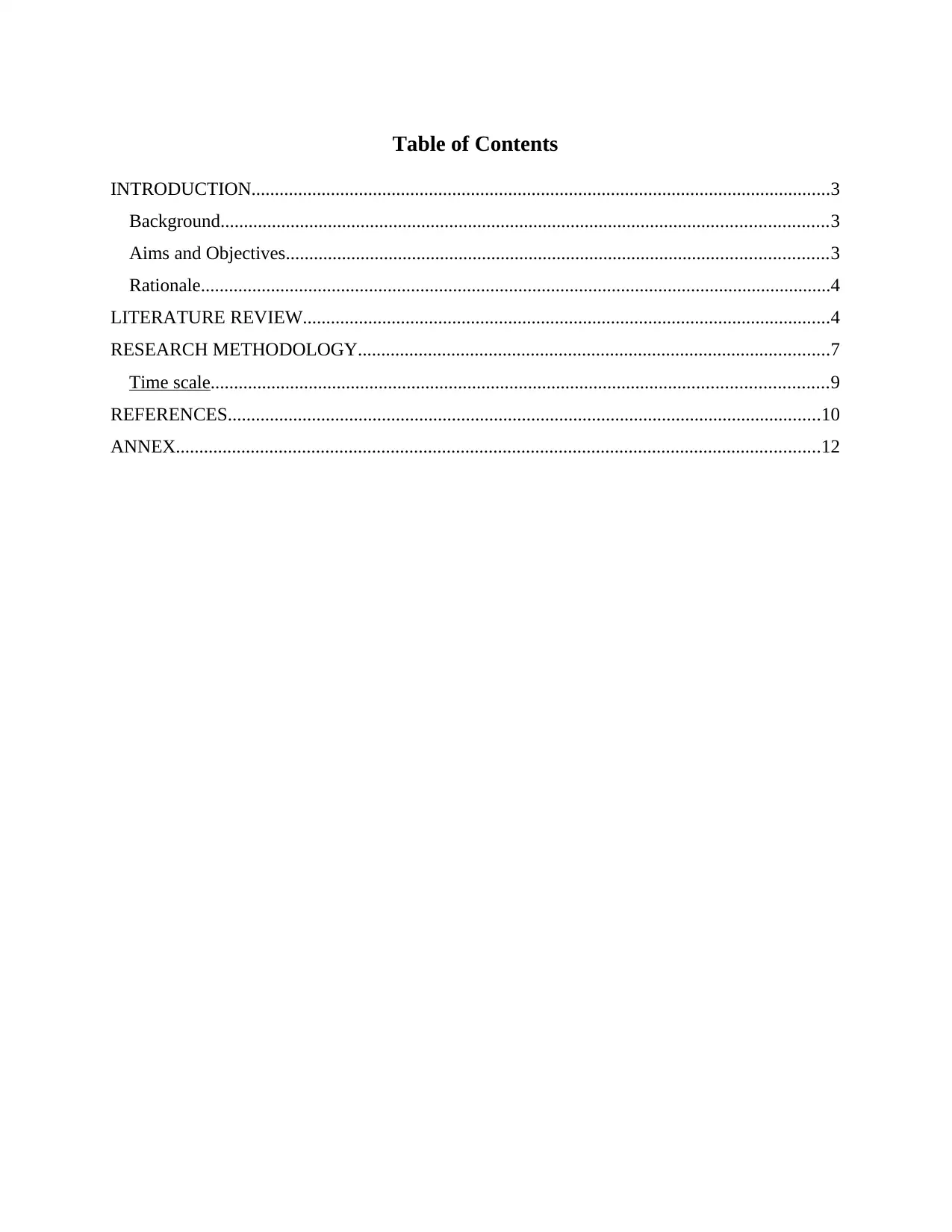
Table of Contents
INTRODUCTION............................................................................................................................3
Background..................................................................................................................................3
Aims and Objectives....................................................................................................................3
Rationale.......................................................................................................................................4
LITERATURE REVIEW.................................................................................................................4
RESEARCH METHODOLOGY.....................................................................................................7
Time scale....................................................................................................................................9
REFERENCES...............................................................................................................................10
ANNEX..........................................................................................................................................12
INTRODUCTION............................................................................................................................3
Background..................................................................................................................................3
Aims and Objectives....................................................................................................................3
Rationale.......................................................................................................................................4
LITERATURE REVIEW.................................................................................................................4
RESEARCH METHODOLOGY.....................................................................................................7
Time scale....................................................................................................................................9
REFERENCES...............................................................................................................................10
ANNEX..........................................................................................................................................12
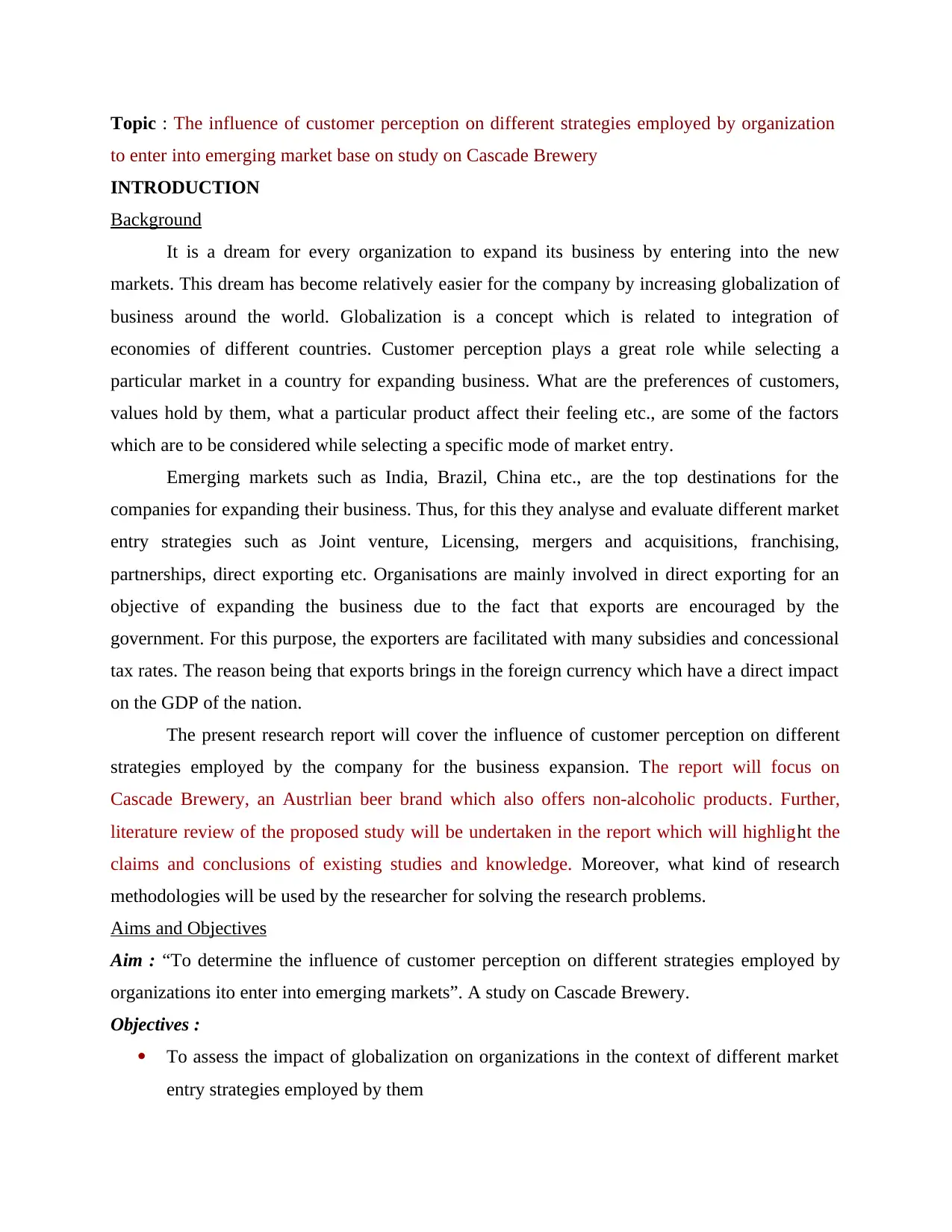
Topic : The influence of customer perception on different strategies employed by organization
to enter into emerging market base on study on Cascade Brewery
INTRODUCTION
Background
It is a dream for every organization to expand its business by entering into the new
markets. This dream has become relatively easier for the company by increasing globalization of
business around the world. Globalization is a concept which is related to integration of
economies of different countries. Customer perception plays a great role while selecting a
particular market in a country for expanding business. What are the preferences of customers,
values hold by them, what a particular product affect their feeling etc., are some of the factors
which are to be considered while selecting a specific mode of market entry.
Emerging markets such as India, Brazil, China etc., are the top destinations for the
companies for expanding their business. Thus, for this they analyse and evaluate different market
entry strategies such as Joint venture, Licensing, mergers and acquisitions, franchising,
partnerships, direct exporting etc. Organisations are mainly involved in direct exporting for an
objective of expanding the business due to the fact that exports are encouraged by the
government. For this purpose, the exporters are facilitated with many subsidies and concessional
tax rates. The reason being that exports brings in the foreign currency which have a direct impact
on the GDP of the nation.
The present research report will cover the influence of customer perception on different
strategies employed by the company for the business expansion. The report will focus on
Cascade Brewery, an Austrlian beer brand which also offers non-alcoholic products. Further,
literature review of the proposed study will be undertaken in the report which will highlight the
claims and conclusions of existing studies and knowledge. Moreover, what kind of research
methodologies will be used by the researcher for solving the research problems.
Aims and Objectives
Aim : “To determine the influence of customer perception on different strategies employed by
organizations ito enter into emerging markets”. A study on Cascade Brewery.
Objectives :
To assess the impact of globalization on organizations in the context of different market
entry strategies employed by them
to enter into emerging market base on study on Cascade Brewery
INTRODUCTION
Background
It is a dream for every organization to expand its business by entering into the new
markets. This dream has become relatively easier for the company by increasing globalization of
business around the world. Globalization is a concept which is related to integration of
economies of different countries. Customer perception plays a great role while selecting a
particular market in a country for expanding business. What are the preferences of customers,
values hold by them, what a particular product affect their feeling etc., are some of the factors
which are to be considered while selecting a specific mode of market entry.
Emerging markets such as India, Brazil, China etc., are the top destinations for the
companies for expanding their business. Thus, for this they analyse and evaluate different market
entry strategies such as Joint venture, Licensing, mergers and acquisitions, franchising,
partnerships, direct exporting etc. Organisations are mainly involved in direct exporting for an
objective of expanding the business due to the fact that exports are encouraged by the
government. For this purpose, the exporters are facilitated with many subsidies and concessional
tax rates. The reason being that exports brings in the foreign currency which have a direct impact
on the GDP of the nation.
The present research report will cover the influence of customer perception on different
strategies employed by the company for the business expansion. The report will focus on
Cascade Brewery, an Austrlian beer brand which also offers non-alcoholic products. Further,
literature review of the proposed study will be undertaken in the report which will highlight the
claims and conclusions of existing studies and knowledge. Moreover, what kind of research
methodologies will be used by the researcher for solving the research problems.
Aims and Objectives
Aim : “To determine the influence of customer perception on different strategies employed by
organizations ito enter into emerging markets”. A study on Cascade Brewery.
Objectives :
To assess the impact of globalization on organizations in the context of different market
entry strategies employed by them
⊘ This is a preview!⊘
Do you want full access?
Subscribe today to unlock all pages.

Trusted by 1+ million students worldwide
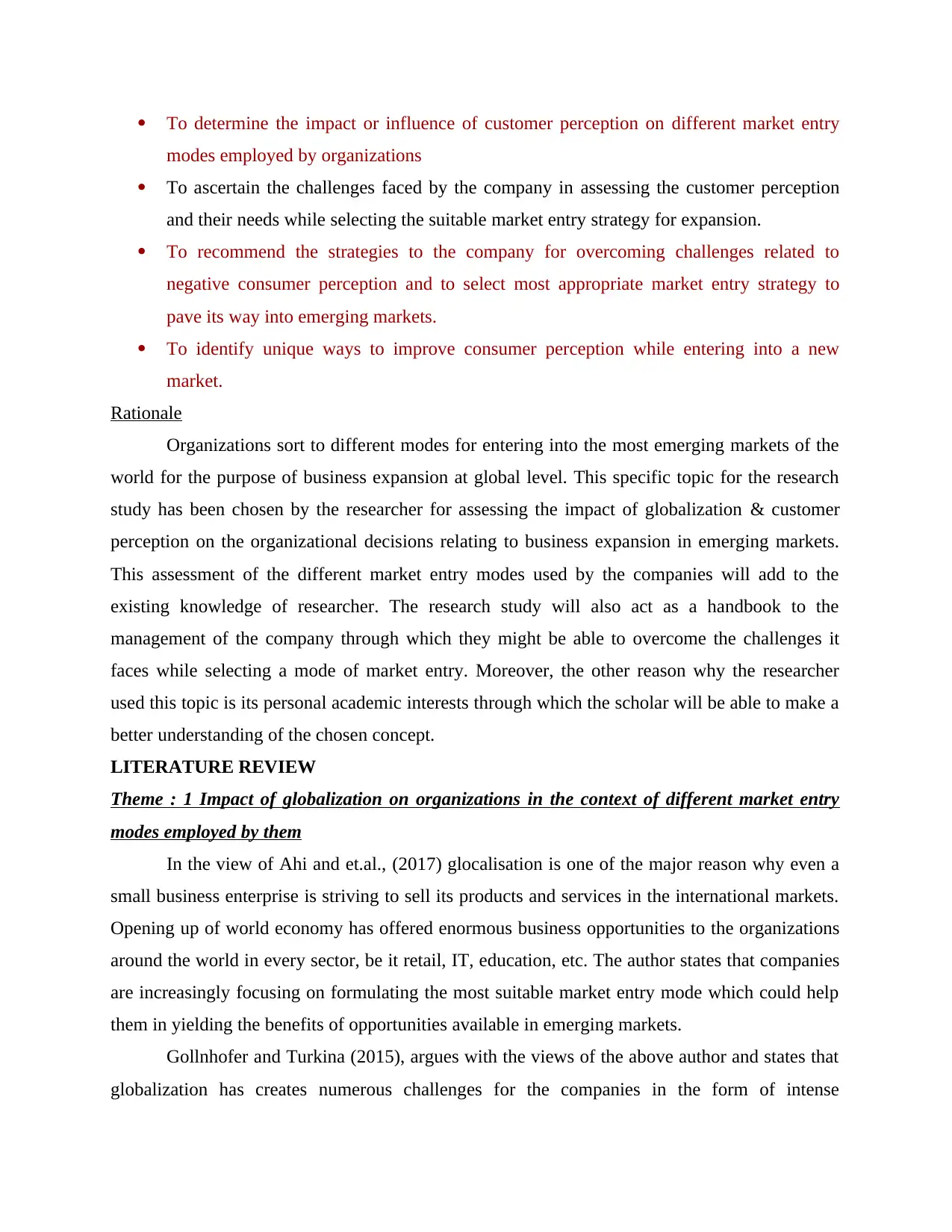
To determine the impact or influence of customer perception on different market entry
modes employed by organizations
To ascertain the challenges faced by the company in assessing the customer perception
and their needs while selecting the suitable market entry strategy for expansion.
To recommend the strategies to the company for overcoming challenges related to
negative consumer perception and to select most appropriate market entry strategy to
pave its way into emerging markets.
To identify unique ways to improve consumer perception while entering into a new
market.
Rationale
Organizations sort to different modes for entering into the most emerging markets of the
world for the purpose of business expansion at global level. This specific topic for the research
study has been chosen by the researcher for assessing the impact of globalization & customer
perception on the organizational decisions relating to business expansion in emerging markets.
This assessment of the different market entry modes used by the companies will add to the
existing knowledge of researcher. The research study will also act as a handbook to the
management of the company through which they might be able to overcome the challenges it
faces while selecting a mode of market entry. Moreover, the other reason why the researcher
used this topic is its personal academic interests through which the scholar will be able to make a
better understanding of the chosen concept.
LITERATURE REVIEW
Theme : 1 Impact of globalization on organizations in the context of different market entry
modes employed by them
In the view of Ahi and et.al., (2017) glocalisation is one of the major reason why even a
small business enterprise is striving to sell its products and services in the international markets.
Opening up of world economy has offered enormous business opportunities to the organizations
around the world in every sector, be it retail, IT, education, etc. The author states that companies
are increasingly focusing on formulating the most suitable market entry mode which could help
them in yielding the benefits of opportunities available in emerging markets.
Gollnhofer and Turkina (2015), argues with the views of the above author and states that
globalization has creates numerous challenges for the companies in the form of intense
modes employed by organizations
To ascertain the challenges faced by the company in assessing the customer perception
and their needs while selecting the suitable market entry strategy for expansion.
To recommend the strategies to the company for overcoming challenges related to
negative consumer perception and to select most appropriate market entry strategy to
pave its way into emerging markets.
To identify unique ways to improve consumer perception while entering into a new
market.
Rationale
Organizations sort to different modes for entering into the most emerging markets of the
world for the purpose of business expansion at global level. This specific topic for the research
study has been chosen by the researcher for assessing the impact of globalization & customer
perception on the organizational decisions relating to business expansion in emerging markets.
This assessment of the different market entry modes used by the companies will add to the
existing knowledge of researcher. The research study will also act as a handbook to the
management of the company through which they might be able to overcome the challenges it
faces while selecting a mode of market entry. Moreover, the other reason why the researcher
used this topic is its personal academic interests through which the scholar will be able to make a
better understanding of the chosen concept.
LITERATURE REVIEW
Theme : 1 Impact of globalization on organizations in the context of different market entry
modes employed by them
In the view of Ahi and et.al., (2017) glocalisation is one of the major reason why even a
small business enterprise is striving to sell its products and services in the international markets.
Opening up of world economy has offered enormous business opportunities to the organizations
around the world in every sector, be it retail, IT, education, etc. The author states that companies
are increasingly focusing on formulating the most suitable market entry mode which could help
them in yielding the benefits of opportunities available in emerging markets.
Gollnhofer and Turkina (2015), argues with the views of the above author and states that
globalization has creates numerous challenges for the companies in the form of intense
Paraphrase This Document
Need a fresh take? Get an instant paraphrase of this document with our AI Paraphraser
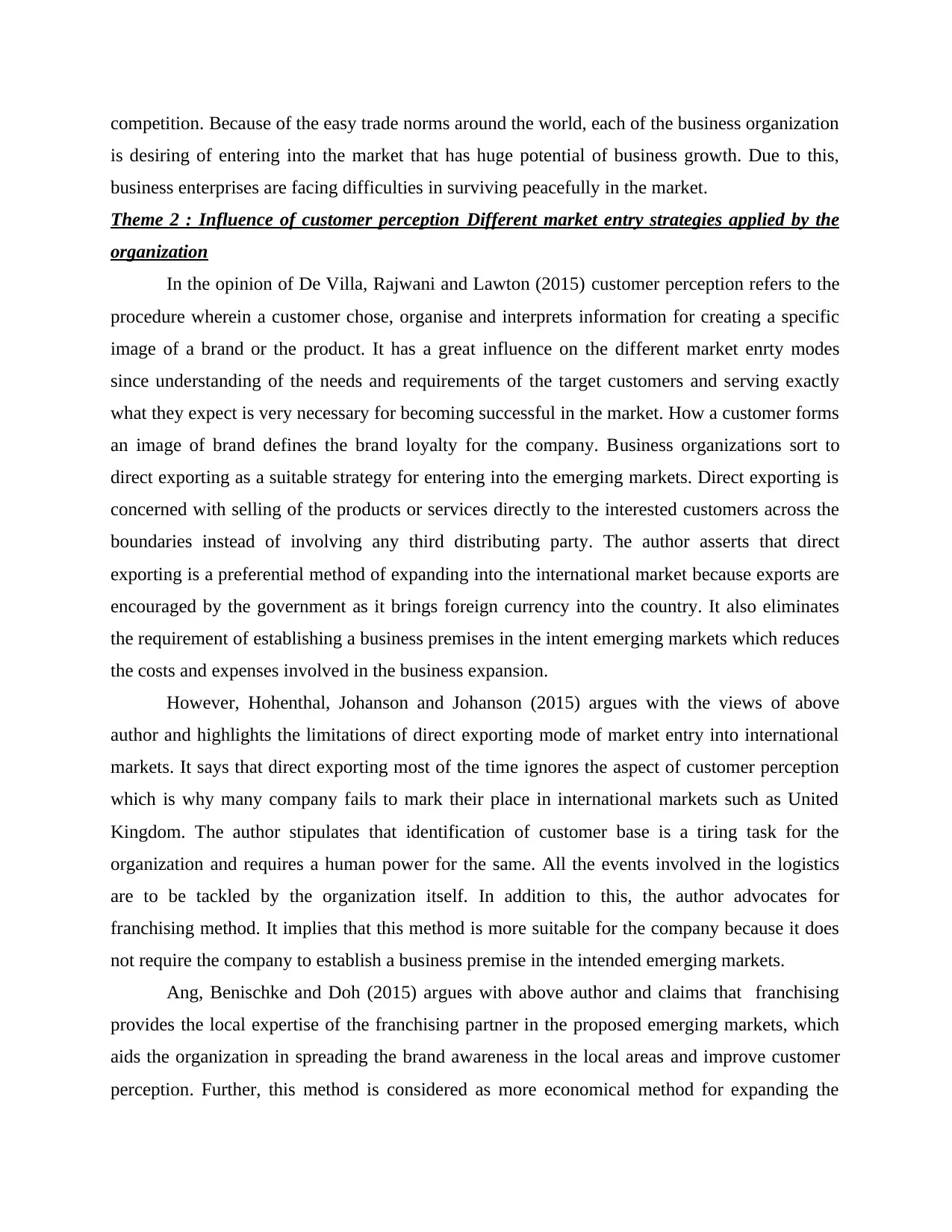
competition. Because of the easy trade norms around the world, each of the business organization
is desiring of entering into the market that has huge potential of business growth. Due to this,
business enterprises are facing difficulties in surviving peacefully in the market.
Theme 2 : Influence of customer perception Different market entry strategies applied by the
organization
In the opinion of De Villa, Rajwani and Lawton (2015) customer perception refers to the
procedure wherein a customer chose, organise and interprets information for creating a specific
image of a brand or the product. It has a great influence on the different market enrty modes
since understanding of the needs and requirements of the target customers and serving exactly
what they expect is very necessary for becoming successful in the market. How a customer forms
an image of brand defines the brand loyalty for the company. Business organizations sort to
direct exporting as a suitable strategy for entering into the emerging markets. Direct exporting is
concerned with selling of the products or services directly to the interested customers across the
boundaries instead of involving any third distributing party. The author asserts that direct
exporting is a preferential method of expanding into the international market because exports are
encouraged by the government as it brings foreign currency into the country. It also eliminates
the requirement of establishing a business premises in the intent emerging markets which reduces
the costs and expenses involved in the business expansion.
However, Hohenthal, Johanson and Johanson (2015) argues with the views of above
author and highlights the limitations of direct exporting mode of market entry into international
markets. It says that direct exporting most of the time ignores the aspect of customer perception
which is why many company fails to mark their place in international markets such as United
Kingdom. The author stipulates that identification of customer base is a tiring task for the
organization and requires a human power for the same. All the events involved in the logistics
are to be tackled by the organization itself. In addition to this, the author advocates for
franchising method. It implies that this method is more suitable for the company because it does
not require the company to establish a business premise in the intended emerging markets.
Ang, Benischke and Doh (2015) argues with above author and claims that franchising
provides the local expertise of the franchising partner in the proposed emerging markets, which
aids the organization in spreading the brand awareness in the local areas and improve customer
perception. Further, this method is considered as more economical method for expanding the
is desiring of entering into the market that has huge potential of business growth. Due to this,
business enterprises are facing difficulties in surviving peacefully in the market.
Theme 2 : Influence of customer perception Different market entry strategies applied by the
organization
In the opinion of De Villa, Rajwani and Lawton (2015) customer perception refers to the
procedure wherein a customer chose, organise and interprets information for creating a specific
image of a brand or the product. It has a great influence on the different market enrty modes
since understanding of the needs and requirements of the target customers and serving exactly
what they expect is very necessary for becoming successful in the market. How a customer forms
an image of brand defines the brand loyalty for the company. Business organizations sort to
direct exporting as a suitable strategy for entering into the emerging markets. Direct exporting is
concerned with selling of the products or services directly to the interested customers across the
boundaries instead of involving any third distributing party. The author asserts that direct
exporting is a preferential method of expanding into the international market because exports are
encouraged by the government as it brings foreign currency into the country. It also eliminates
the requirement of establishing a business premises in the intent emerging markets which reduces
the costs and expenses involved in the business expansion.
However, Hohenthal, Johanson and Johanson (2015) argues with the views of above
author and highlights the limitations of direct exporting mode of market entry into international
markets. It says that direct exporting most of the time ignores the aspect of customer perception
which is why many company fails to mark their place in international markets such as United
Kingdom. The author stipulates that identification of customer base is a tiring task for the
organization and requires a human power for the same. All the events involved in the logistics
are to be tackled by the organization itself. In addition to this, the author advocates for
franchising method. It implies that this method is more suitable for the company because it does
not require the company to establish a business premise in the intended emerging markets.
Ang, Benischke and Doh (2015) argues with above author and claims that franchising
provides the local expertise of the franchising partner in the proposed emerging markets, which
aids the organization in spreading the brand awareness in the local areas and improve customer
perception. Further, this method is considered as more economical method for expanding the
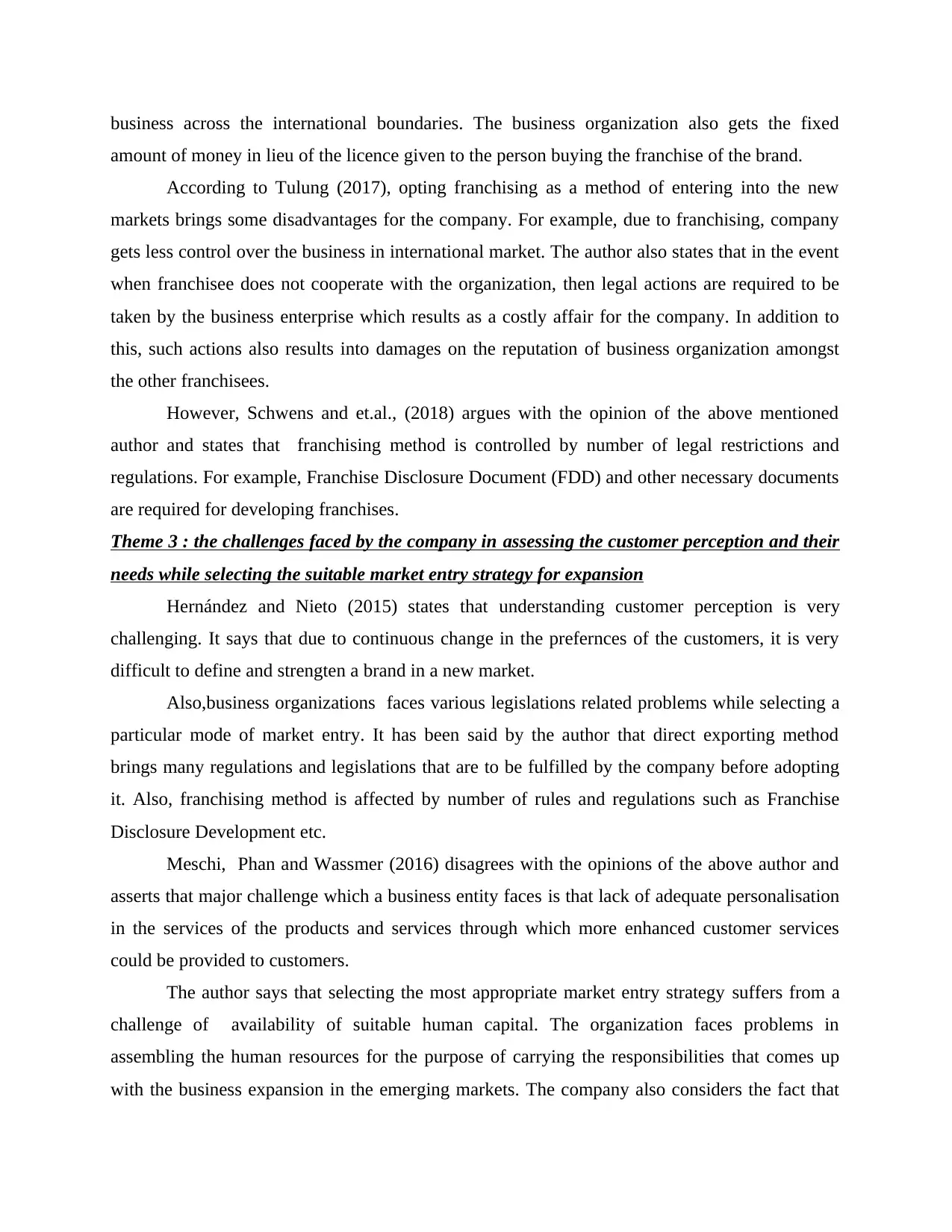
business across the international boundaries. The business organization also gets the fixed
amount of money in lieu of the licence given to the person buying the franchise of the brand.
According to Tulung (2017), opting franchising as a method of entering into the new
markets brings some disadvantages for the company. For example, due to franchising, company
gets less control over the business in international market. The author also states that in the event
when franchisee does not cooperate with the organization, then legal actions are required to be
taken by the business enterprise which results as a costly affair for the company. In addition to
this, such actions also results into damages on the reputation of business organization amongst
the other franchisees.
However, Schwens and et.al., (2018) argues with the opinion of the above mentioned
author and states that franchising method is controlled by number of legal restrictions and
regulations. For example, Franchise Disclosure Document (FDD) and other necessary documents
are required for developing franchises.
Theme 3 : the challenges faced by the company in assessing the customer perception and their
needs while selecting the suitable market entry strategy for expansion
Hernández and Nieto (2015) states that understanding customer perception is very
challenging. It says that due to continuous change in the prefernces of the customers, it is very
difficult to define and strengten a brand in a new market.
Also,business organizations faces various legislations related problems while selecting a
particular mode of market entry. It has been said by the author that direct exporting method
brings many regulations and legislations that are to be fulfilled by the company before adopting
it. Also, franchising method is affected by number of rules and regulations such as Franchise
Disclosure Development etc.
Meschi, Phan and Wassmer (2016) disagrees with the opinions of the above author and
asserts that major challenge which a business entity faces is that lack of adequate personalisation
in the services of the products and services through which more enhanced customer services
could be provided to customers.
The author says that selecting the most appropriate market entry strategy suffers from a
challenge of availability of suitable human capital. The organization faces problems in
assembling the human resources for the purpose of carrying the responsibilities that comes up
with the business expansion in the emerging markets. The company also considers the fact that
amount of money in lieu of the licence given to the person buying the franchise of the brand.
According to Tulung (2017), opting franchising as a method of entering into the new
markets brings some disadvantages for the company. For example, due to franchising, company
gets less control over the business in international market. The author also states that in the event
when franchisee does not cooperate with the organization, then legal actions are required to be
taken by the business enterprise which results as a costly affair for the company. In addition to
this, such actions also results into damages on the reputation of business organization amongst
the other franchisees.
However, Schwens and et.al., (2018) argues with the opinion of the above mentioned
author and states that franchising method is controlled by number of legal restrictions and
regulations. For example, Franchise Disclosure Document (FDD) and other necessary documents
are required for developing franchises.
Theme 3 : the challenges faced by the company in assessing the customer perception and their
needs while selecting the suitable market entry strategy for expansion
Hernández and Nieto (2015) states that understanding customer perception is very
challenging. It says that due to continuous change in the prefernces of the customers, it is very
difficult to define and strengten a brand in a new market.
Also,business organizations faces various legislations related problems while selecting a
particular mode of market entry. It has been said by the author that direct exporting method
brings many regulations and legislations that are to be fulfilled by the company before adopting
it. Also, franchising method is affected by number of rules and regulations such as Franchise
Disclosure Development etc.
Meschi, Phan and Wassmer (2016) disagrees with the opinions of the above author and
asserts that major challenge which a business entity faces is that lack of adequate personalisation
in the services of the products and services through which more enhanced customer services
could be provided to customers.
The author says that selecting the most appropriate market entry strategy suffers from a
challenge of availability of suitable human capital. The organization faces problems in
assembling the human resources for the purpose of carrying the responsibilities that comes up
with the business expansion in the emerging markets. The company also considers the fact that
⊘ This is a preview!⊘
Do you want full access?
Subscribe today to unlock all pages.

Trusted by 1+ million students worldwide
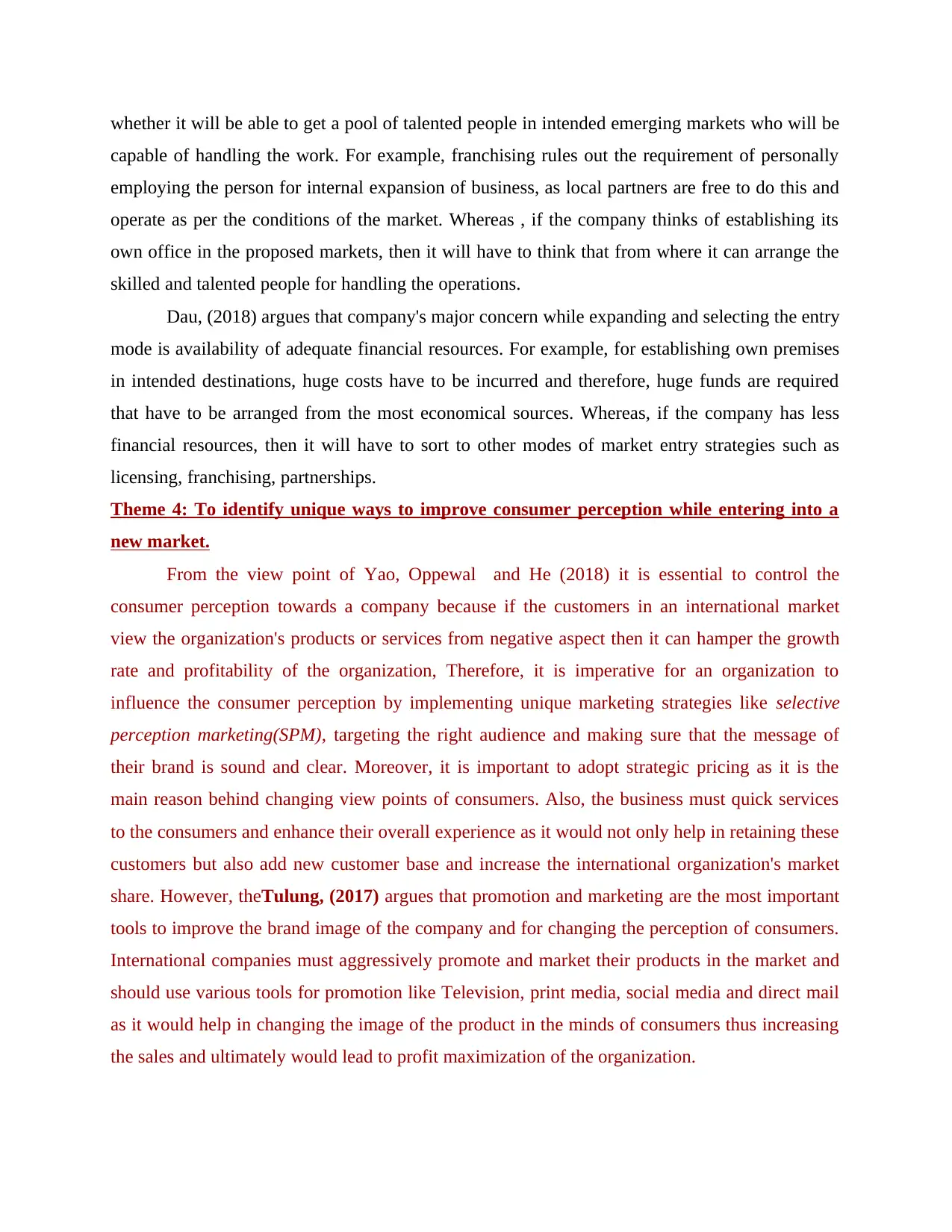
whether it will be able to get a pool of talented people in intended emerging markets who will be
capable of handling the work. For example, franchising rules out the requirement of personally
employing the person for internal expansion of business, as local partners are free to do this and
operate as per the conditions of the market. Whereas , if the company thinks of establishing its
own office in the proposed markets, then it will have to think that from where it can arrange the
skilled and talented people for handling the operations.
Dau, (2018) argues that company's major concern while expanding and selecting the entry
mode is availability of adequate financial resources. For example, for establishing own premises
in intended destinations, huge costs have to be incurred and therefore, huge funds are required
that have to be arranged from the most economical sources. Whereas, if the company has less
financial resources, then it will have to sort to other modes of market entry strategies such as
licensing, franchising, partnerships.
Theme 4: To identify unique ways to improve consumer perception while entering into a
new market.
From the view point of Yao, Oppewal and He (2018) it is essential to control the
consumer perception towards a company because if the customers in an international market
view the organization's products or services from negative aspect then it can hamper the growth
rate and profitability of the organization, Therefore, it is imperative for an organization to
influence the consumer perception by implementing unique marketing strategies like selective
perception marketing(SPM), targeting the right audience and making sure that the message of
their brand is sound and clear. Moreover, it is important to adopt strategic pricing as it is the
main reason behind changing view points of consumers. Also, the business must quick services
to the consumers and enhance their overall experience as it would not only help in retaining these
customers but also add new customer base and increase the international organization's market
share. However, theTulung, (2017) argues that promotion and marketing are the most important
tools to improve the brand image of the company and for changing the perception of consumers.
International companies must aggressively promote and market their products in the market and
should use various tools for promotion like Television, print media, social media and direct mail
as it would help in changing the image of the product in the minds of consumers thus increasing
the sales and ultimately would lead to profit maximization of the organization.
capable of handling the work. For example, franchising rules out the requirement of personally
employing the person for internal expansion of business, as local partners are free to do this and
operate as per the conditions of the market. Whereas , if the company thinks of establishing its
own office in the proposed markets, then it will have to think that from where it can arrange the
skilled and talented people for handling the operations.
Dau, (2018) argues that company's major concern while expanding and selecting the entry
mode is availability of adequate financial resources. For example, for establishing own premises
in intended destinations, huge costs have to be incurred and therefore, huge funds are required
that have to be arranged from the most economical sources. Whereas, if the company has less
financial resources, then it will have to sort to other modes of market entry strategies such as
licensing, franchising, partnerships.
Theme 4: To identify unique ways to improve consumer perception while entering into a
new market.
From the view point of Yao, Oppewal and He (2018) it is essential to control the
consumer perception towards a company because if the customers in an international market
view the organization's products or services from negative aspect then it can hamper the growth
rate and profitability of the organization, Therefore, it is imperative for an organization to
influence the consumer perception by implementing unique marketing strategies like selective
perception marketing(SPM), targeting the right audience and making sure that the message of
their brand is sound and clear. Moreover, it is important to adopt strategic pricing as it is the
main reason behind changing view points of consumers. Also, the business must quick services
to the consumers and enhance their overall experience as it would not only help in retaining these
customers but also add new customer base and increase the international organization's market
share. However, theTulung, (2017) argues that promotion and marketing are the most important
tools to improve the brand image of the company and for changing the perception of consumers.
International companies must aggressively promote and market their products in the market and
should use various tools for promotion like Television, print media, social media and direct mail
as it would help in changing the image of the product in the minds of consumers thus increasing
the sales and ultimately would lead to profit maximization of the organization.
Paraphrase This Document
Need a fresh take? Get an instant paraphrase of this document with our AI Paraphraser
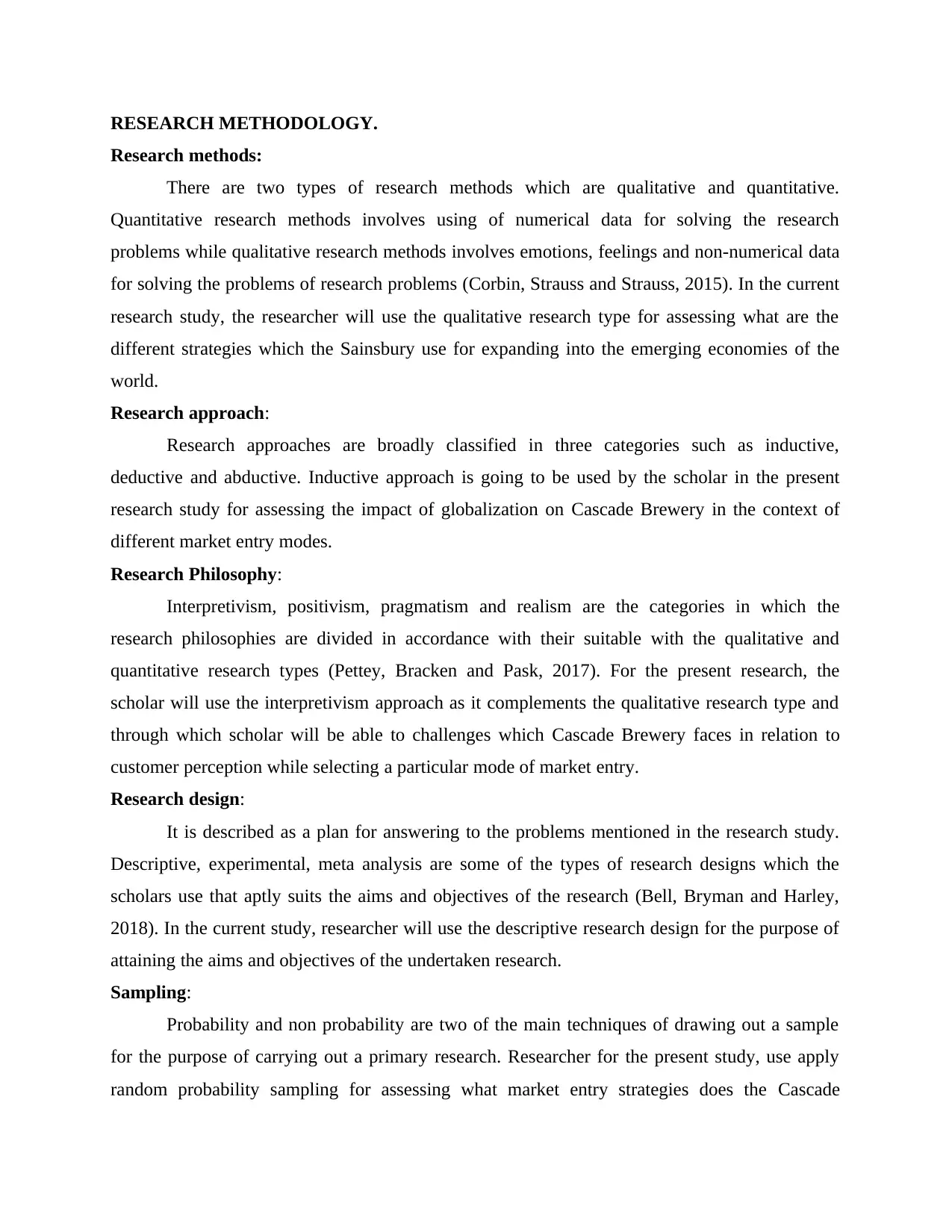
RESEARCH METHODOLOGY.
Research methods:
There are two types of research methods which are qualitative and quantitative.
Quantitative research methods involves using of numerical data for solving the research
problems while qualitative research methods involves emotions, feelings and non-numerical data
for solving the problems of research problems (Corbin, Strauss and Strauss, 2015). In the current
research study, the researcher will use the qualitative research type for assessing what are the
different strategies which the Sainsbury use for expanding into the emerging economies of the
world.
Research approach:
Research approaches are broadly classified in three categories such as inductive,
deductive and abductive. Inductive approach is going to be used by the scholar in the present
research study for assessing the impact of globalization on Cascade Brewery in the context of
different market entry modes.
Research Philosophy:
Interpretivism, positivism, pragmatism and realism are the categories in which the
research philosophies are divided in accordance with their suitable with the qualitative and
quantitative research types (Pettey, Bracken and Pask, 2017). For the present research, the
scholar will use the interpretivism approach as it complements the qualitative research type and
through which scholar will be able to challenges which Cascade Brewery faces in relation to
customer perception while selecting a particular mode of market entry.
Research design:
It is described as a plan for answering to the problems mentioned in the research study.
Descriptive, experimental, meta analysis are some of the types of research designs which the
scholars use that aptly suits the aims and objectives of the research (Bell, Bryman and Harley,
2018). In the current study, researcher will use the descriptive research design for the purpose of
attaining the aims and objectives of the undertaken research.
Sampling:
Probability and non probability are two of the main techniques of drawing out a sample
for the purpose of carrying out a primary research. Researcher for the present study, use apply
random probability sampling for assessing what market entry strategies does the Cascade
Research methods:
There are two types of research methods which are qualitative and quantitative.
Quantitative research methods involves using of numerical data for solving the research
problems while qualitative research methods involves emotions, feelings and non-numerical data
for solving the problems of research problems (Corbin, Strauss and Strauss, 2015). In the current
research study, the researcher will use the qualitative research type for assessing what are the
different strategies which the Sainsbury use for expanding into the emerging economies of the
world.
Research approach:
Research approaches are broadly classified in three categories such as inductive,
deductive and abductive. Inductive approach is going to be used by the scholar in the present
research study for assessing the impact of globalization on Cascade Brewery in the context of
different market entry modes.
Research Philosophy:
Interpretivism, positivism, pragmatism and realism are the categories in which the
research philosophies are divided in accordance with their suitable with the qualitative and
quantitative research types (Pettey, Bracken and Pask, 2017). For the present research, the
scholar will use the interpretivism approach as it complements the qualitative research type and
through which scholar will be able to challenges which Cascade Brewery faces in relation to
customer perception while selecting a particular mode of market entry.
Research design:
It is described as a plan for answering to the problems mentioned in the research study.
Descriptive, experimental, meta analysis are some of the types of research designs which the
scholars use that aptly suits the aims and objectives of the research (Bell, Bryman and Harley,
2018). In the current study, researcher will use the descriptive research design for the purpose of
attaining the aims and objectives of the undertaken research.
Sampling:
Probability and non probability are two of the main techniques of drawing out a sample
for the purpose of carrying out a primary research. Researcher for the present study, use apply
random probability sampling for assessing what market entry strategies does the Cascade
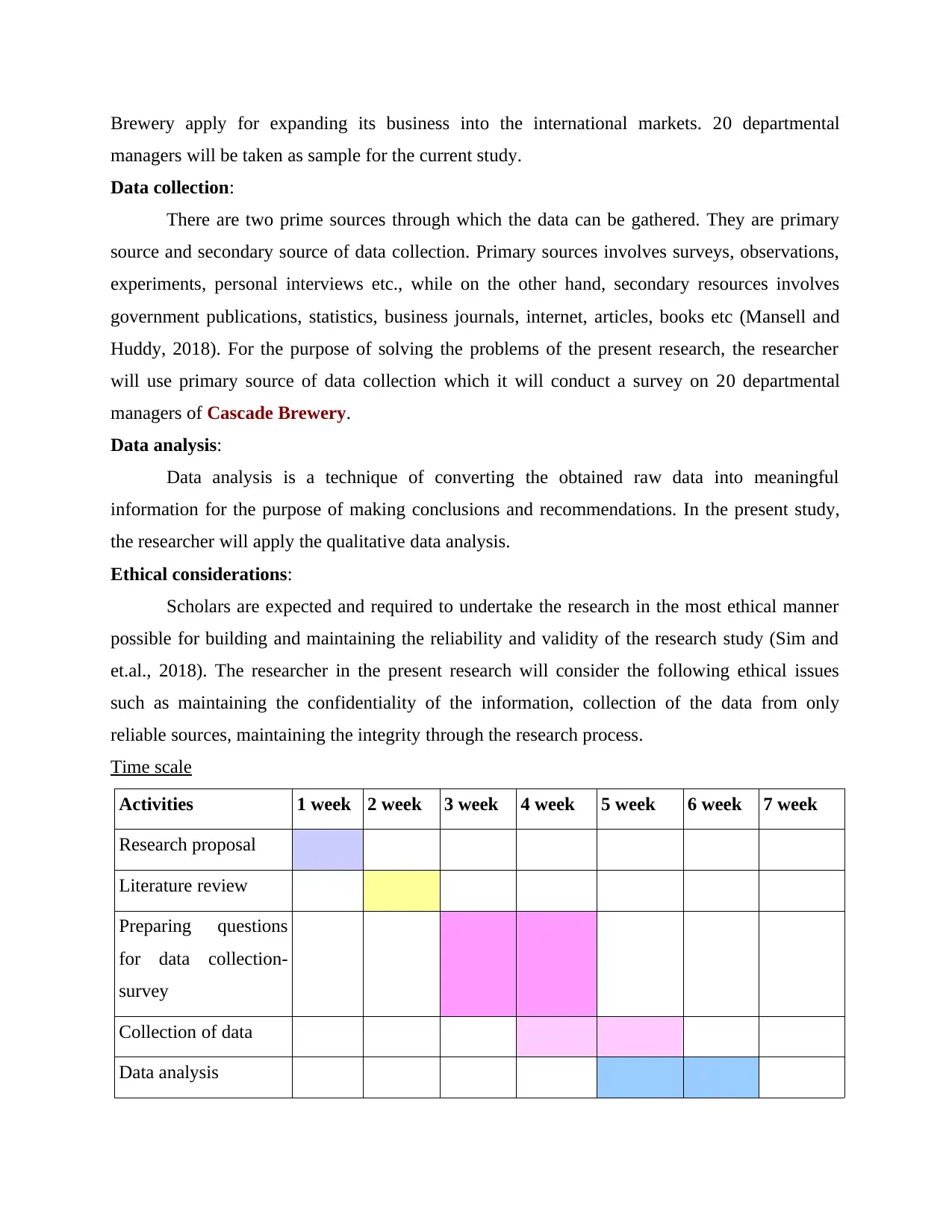
Brewery apply for expanding its business into the international markets. 20 departmental
managers will be taken as sample for the current study.
Data collection:
There are two prime sources through which the data can be gathered. They are primary
source and secondary source of data collection. Primary sources involves surveys, observations,
experiments, personal interviews etc., while on the other hand, secondary resources involves
government publications, statistics, business journals, internet, articles, books etc (Mansell and
Huddy, 2018). For the purpose of solving the problems of the present research, the researcher
will use primary source of data collection which it will conduct a survey on 20 departmental
managers of Cascade Brewery.
Data analysis:
Data analysis is a technique of converting the obtained raw data into meaningful
information for the purpose of making conclusions and recommendations. In the present study,
the researcher will apply the qualitative data analysis.
Ethical considerations:
Scholars are expected and required to undertake the research in the most ethical manner
possible for building and maintaining the reliability and validity of the research study (Sim and
et.al., 2018). The researcher in the present research will consider the following ethical issues
such as maintaining the confidentiality of the information, collection of the data from only
reliable sources, maintaining the integrity through the research process.
Time scale
Activities 1 week 2 week 3 week 4 week 5 week 6 week 7 week
Research proposal
Literature review
Preparing questions
for data collection-
survey
Collection of data
Data analysis
managers will be taken as sample for the current study.
Data collection:
There are two prime sources through which the data can be gathered. They are primary
source and secondary source of data collection. Primary sources involves surveys, observations,
experiments, personal interviews etc., while on the other hand, secondary resources involves
government publications, statistics, business journals, internet, articles, books etc (Mansell and
Huddy, 2018). For the purpose of solving the problems of the present research, the researcher
will use primary source of data collection which it will conduct a survey on 20 departmental
managers of Cascade Brewery.
Data analysis:
Data analysis is a technique of converting the obtained raw data into meaningful
information for the purpose of making conclusions and recommendations. In the present study,
the researcher will apply the qualitative data analysis.
Ethical considerations:
Scholars are expected and required to undertake the research in the most ethical manner
possible for building and maintaining the reliability and validity of the research study (Sim and
et.al., 2018). The researcher in the present research will consider the following ethical issues
such as maintaining the confidentiality of the information, collection of the data from only
reliable sources, maintaining the integrity through the research process.
Time scale
Activities 1 week 2 week 3 week 4 week 5 week 6 week 7 week
Research proposal
Literature review
Preparing questions
for data collection-
survey
Collection of data
Data analysis
⊘ This is a preview!⊘
Do you want full access?
Subscribe today to unlock all pages.

Trusted by 1+ million students worldwide

Recommendations
and reflections
Conclusion
and reflections
Conclusion
Paraphrase This Document
Need a fresh take? Get an instant paraphrase of this document with our AI Paraphraser
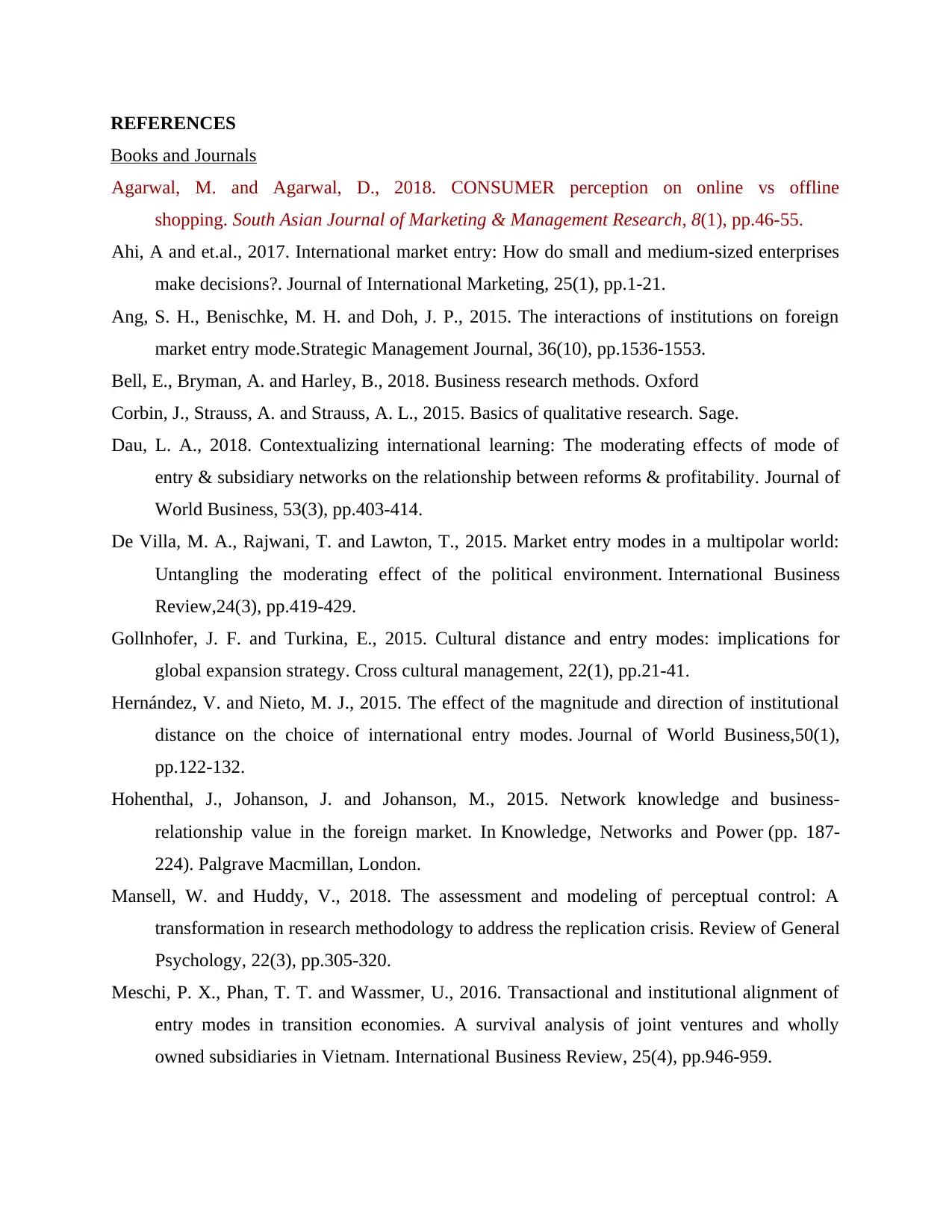
REFERENCES
Books and Journals
Agarwal, M. and Agarwal, D., 2018. CONSUMER perception on online vs offline
shopping. South Asian Journal of Marketing & Management Research, 8(1), pp.46-55.
Ahi, A and et.al., 2017. International market entry: How do small and medium-sized enterprises
make decisions?. Journal of International Marketing, 25(1), pp.1-21.
Ang, S. H., Benischke, M. H. and Doh, J. P., 2015. The interactions of institutions on foreign
market entry mode.Strategic Management Journal, 36(10), pp.1536-1553.
Bell, E., Bryman, A. and Harley, B., 2018. Business research methods. Oxford
Corbin, J., Strauss, A. and Strauss, A. L., 2015. Basics of qualitative research. Sage.
Dau, L. A., 2018. Contextualizing international learning: The moderating effects of mode of
entry & subsidiary networks on the relationship between reforms & profitability. Journal of
World Business, 53(3), pp.403-414.
De Villa, M. A., Rajwani, T. and Lawton, T., 2015. Market entry modes in a multipolar world:
Untangling the moderating effect of the political environment. International Business
Review,24(3), pp.419-429.
Gollnhofer, J. F. and Turkina, E., 2015. Cultural distance and entry modes: implications for
global expansion strategy. Cross cultural management, 22(1), pp.21-41.
Hernández, V. and Nieto, M. J., 2015. The effect of the magnitude and direction of institutional
distance on the choice of international entry modes. Journal of World Business,50(1),
pp.122-132.
Hohenthal, J., Johanson, J. and Johanson, M., 2015. Network knowledge and business-
relationship value in the foreign market. In Knowledge, Networks and Power (pp. 187-
224). Palgrave Macmillan, London.
Mansell, W. and Huddy, V., 2018. The assessment and modeling of perceptual control: A
transformation in research methodology to address the replication crisis. Review of General
Psychology, 22(3), pp.305-320.
Meschi, P. X., Phan, T. T. and Wassmer, U., 2016. Transactional and institutional alignment of
entry modes in transition economies. A survival analysis of joint ventures and wholly
owned subsidiaries in Vietnam. International Business Review, 25(4), pp.946-959.
Books and Journals
Agarwal, M. and Agarwal, D., 2018. CONSUMER perception on online vs offline
shopping. South Asian Journal of Marketing & Management Research, 8(1), pp.46-55.
Ahi, A and et.al., 2017. International market entry: How do small and medium-sized enterprises
make decisions?. Journal of International Marketing, 25(1), pp.1-21.
Ang, S. H., Benischke, M. H. and Doh, J. P., 2015. The interactions of institutions on foreign
market entry mode.Strategic Management Journal, 36(10), pp.1536-1553.
Bell, E., Bryman, A. and Harley, B., 2018. Business research methods. Oxford
Corbin, J., Strauss, A. and Strauss, A. L., 2015. Basics of qualitative research. Sage.
Dau, L. A., 2018. Contextualizing international learning: The moderating effects of mode of
entry & subsidiary networks on the relationship between reforms & profitability. Journal of
World Business, 53(3), pp.403-414.
De Villa, M. A., Rajwani, T. and Lawton, T., 2015. Market entry modes in a multipolar world:
Untangling the moderating effect of the political environment. International Business
Review,24(3), pp.419-429.
Gollnhofer, J. F. and Turkina, E., 2015. Cultural distance and entry modes: implications for
global expansion strategy. Cross cultural management, 22(1), pp.21-41.
Hernández, V. and Nieto, M. J., 2015. The effect of the magnitude and direction of institutional
distance on the choice of international entry modes. Journal of World Business,50(1),
pp.122-132.
Hohenthal, J., Johanson, J. and Johanson, M., 2015. Network knowledge and business-
relationship value in the foreign market. In Knowledge, Networks and Power (pp. 187-
224). Palgrave Macmillan, London.
Mansell, W. and Huddy, V., 2018. The assessment and modeling of perceptual control: A
transformation in research methodology to address the replication crisis. Review of General
Psychology, 22(3), pp.305-320.
Meschi, P. X., Phan, T. T. and Wassmer, U., 2016. Transactional and institutional alignment of
entry modes in transition economies. A survival analysis of joint ventures and wholly
owned subsidiaries in Vietnam. International Business Review, 25(4), pp.946-959.
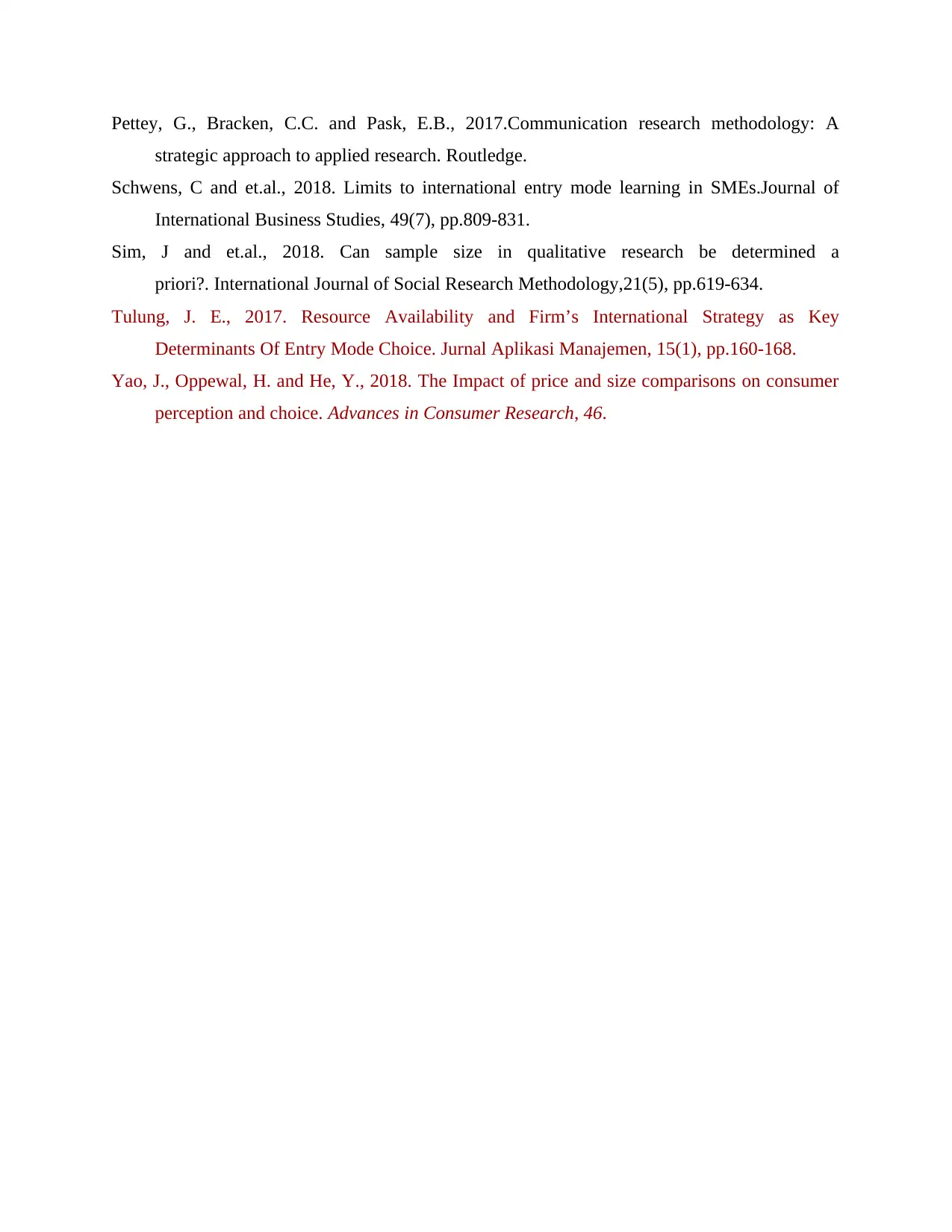
Pettey, G., Bracken, C.C. and Pask, E.B., 2017.Communication research methodology: A
strategic approach to applied research. Routledge.
Schwens, C and et.al., 2018. Limits to international entry mode learning in SMEs.Journal of
International Business Studies, 49(7), pp.809-831.
Sim, J and et.al., 2018. Can sample size in qualitative research be determined a
priori?. International Journal of Social Research Methodology,21(5), pp.619-634.
Tulung, J. E., 2017. Resource Availability and Firm’s International Strategy as Key
Determinants Of Entry Mode Choice. Jurnal Aplikasi Manajemen, 15(1), pp.160-168.
Yao, J., Oppewal, H. and He, Y., 2018. The Impact of price and size comparisons on consumer
perception and choice. Advances in Consumer Research, 46.
strategic approach to applied research. Routledge.
Schwens, C and et.al., 2018. Limits to international entry mode learning in SMEs.Journal of
International Business Studies, 49(7), pp.809-831.
Sim, J and et.al., 2018. Can sample size in qualitative research be determined a
priori?. International Journal of Social Research Methodology,21(5), pp.619-634.
Tulung, J. E., 2017. Resource Availability and Firm’s International Strategy as Key
Determinants Of Entry Mode Choice. Jurnal Aplikasi Manajemen, 15(1), pp.160-168.
Yao, J., Oppewal, H. and He, Y., 2018. The Impact of price and size comparisons on consumer
perception and choice. Advances in Consumer Research, 46.
⊘ This is a preview!⊘
Do you want full access?
Subscribe today to unlock all pages.

Trusted by 1+ million students worldwide
1 out of 19
Related Documents
Your All-in-One AI-Powered Toolkit for Academic Success.
+13062052269
info@desklib.com
Available 24*7 on WhatsApp / Email
![[object Object]](/_next/static/media/star-bottom.7253800d.svg)
Unlock your academic potential
Copyright © 2020–2025 A2Z Services. All Rights Reserved. Developed and managed by ZUCOL.





